(新课标)Unit 1 School and Friends Lesson 1 Hello 分层练习(含答案)
文档属性
| 名称 | (新课标)Unit 1 School and Friends Lesson 1 Hello 分层练习(含答案) | 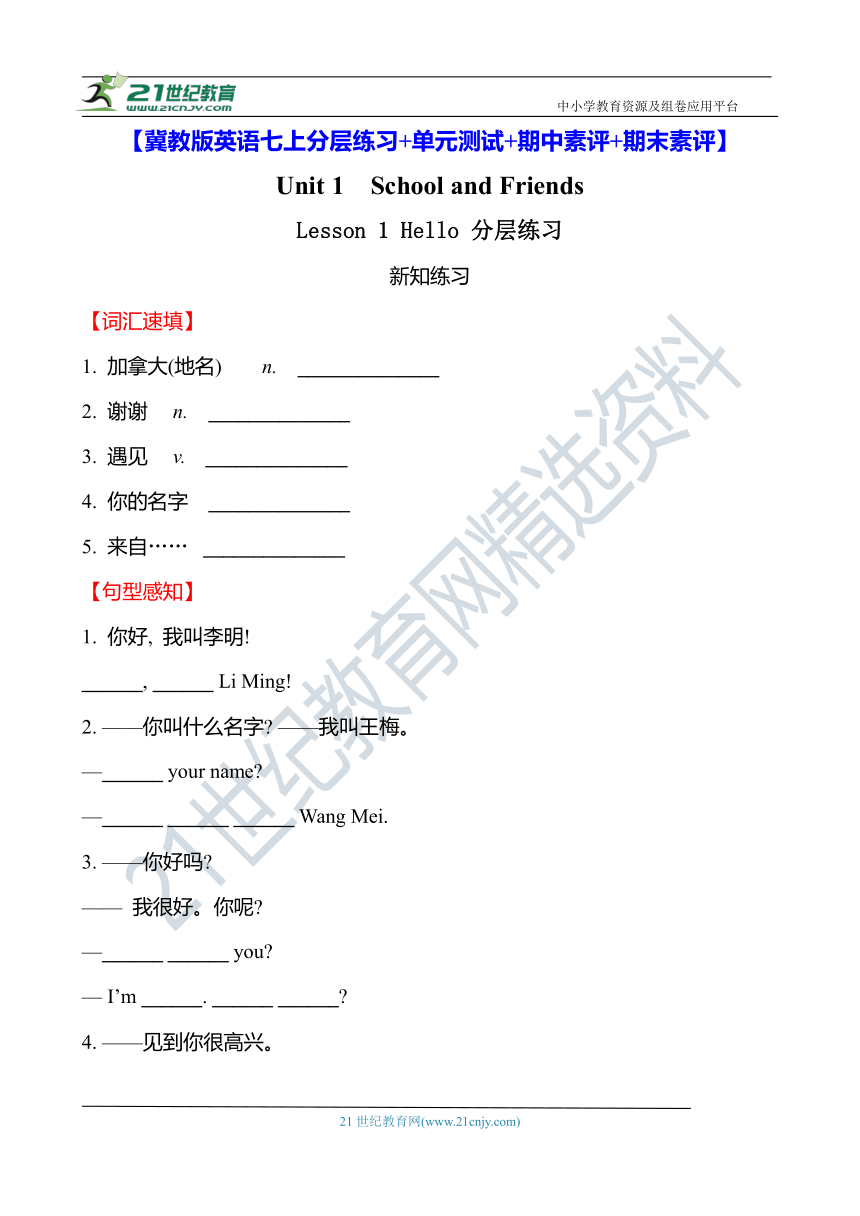 | |
| 格式 | doc | ||
| 文件大小 | 1.8MB | ||
| 资源类型 | 试卷 | ||
| 版本资源 | 冀教版 | ||
| 科目 | 英语 | ||
| 更新时间 | 2022-07-05 15:51:12 | ||
图片预览

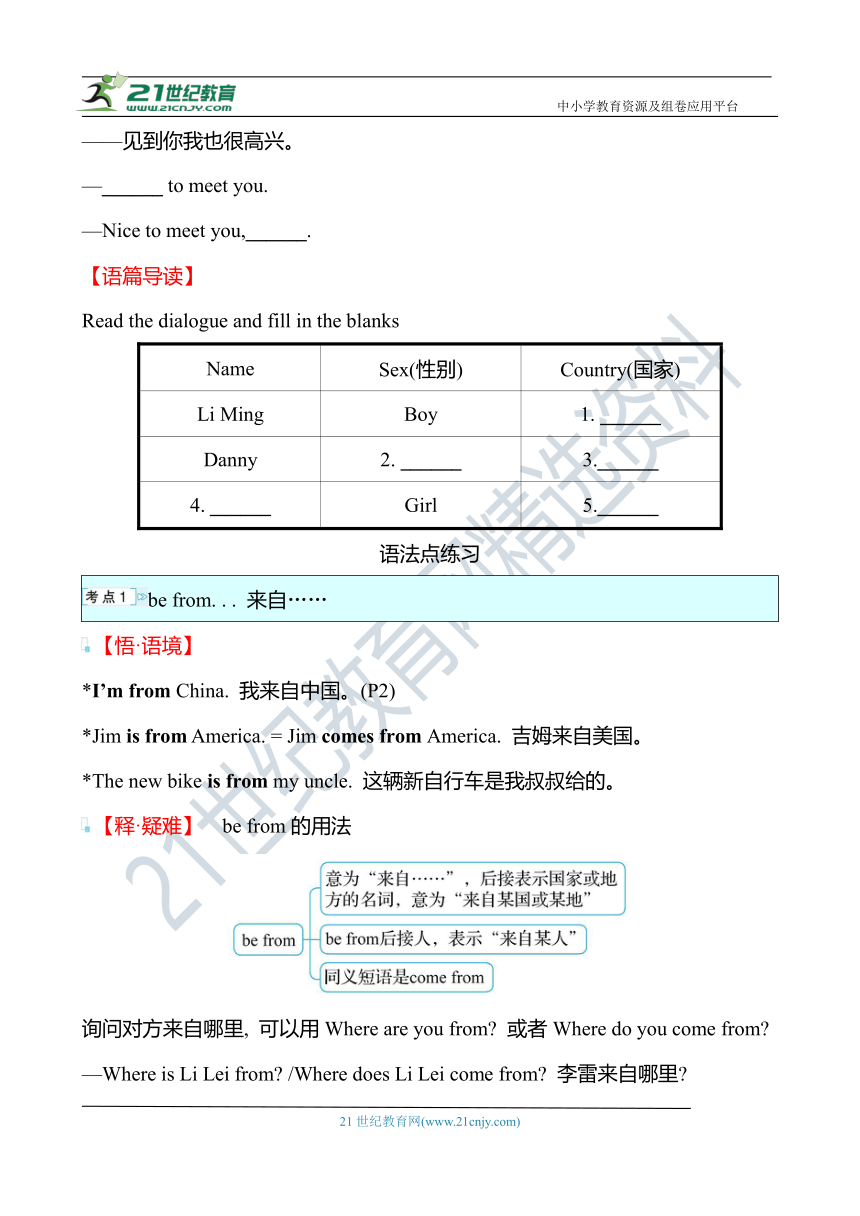
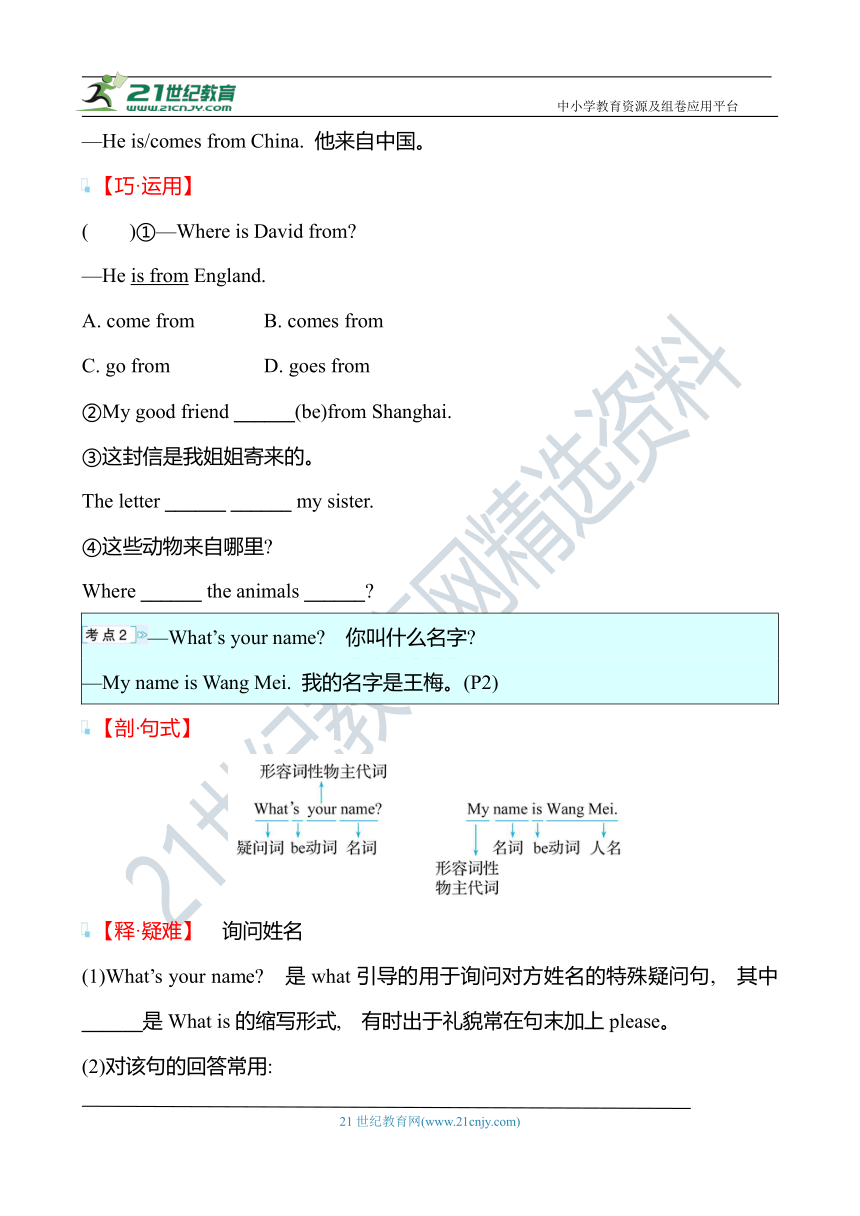
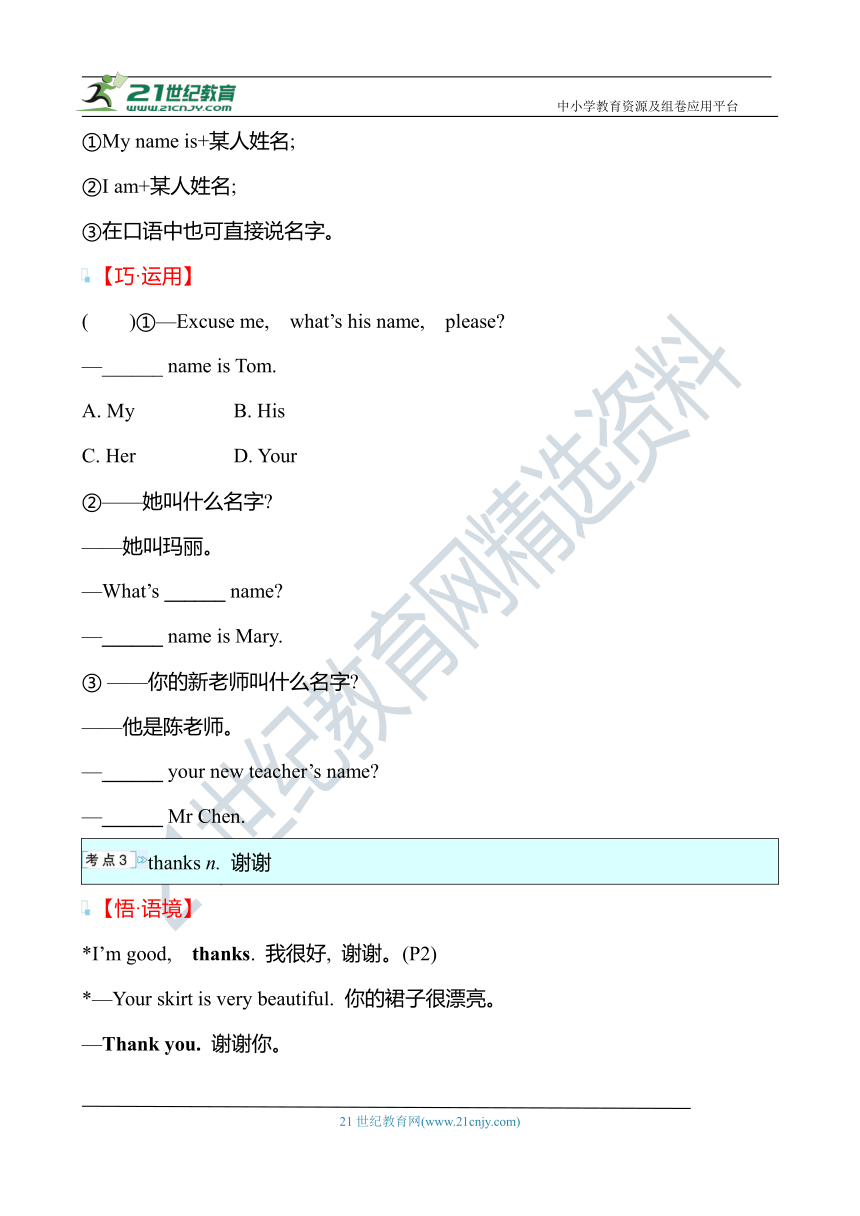
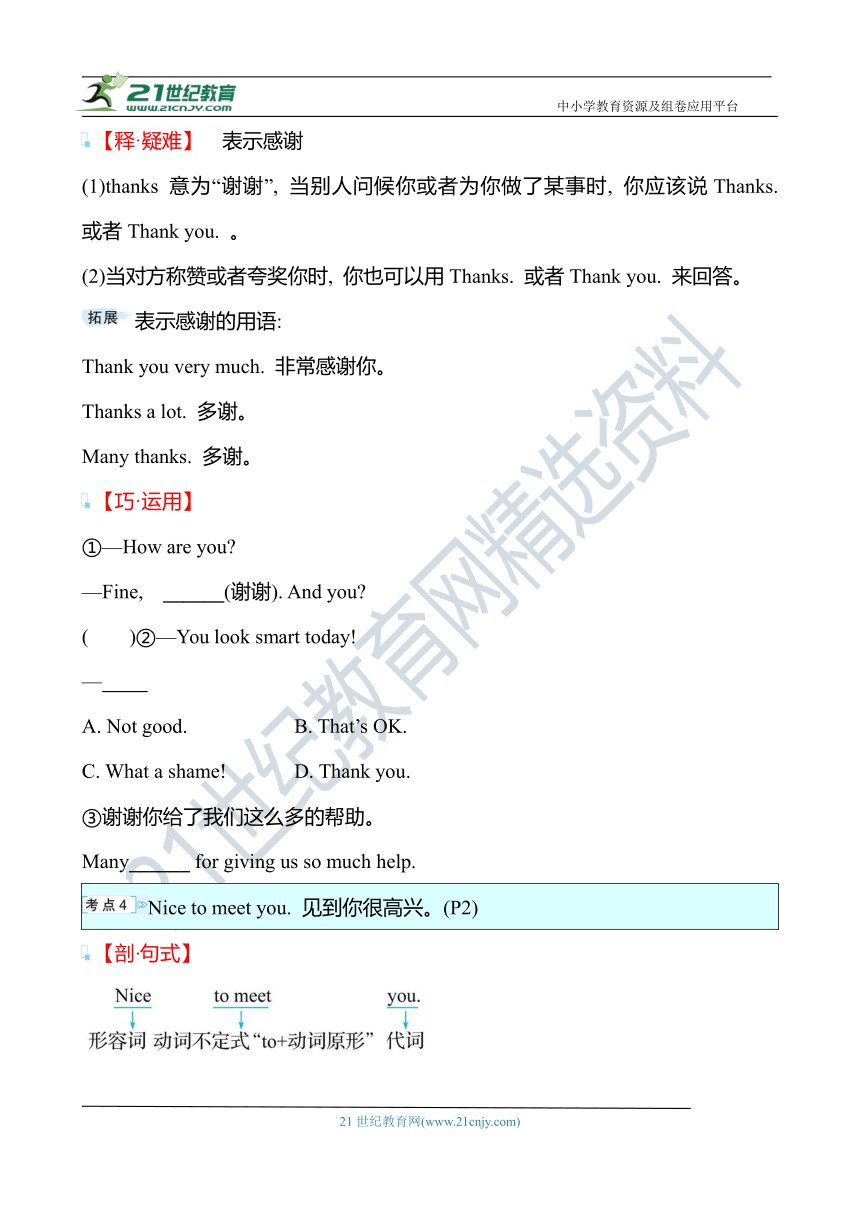
文档简介
中小学教育资源及组卷应用平台
【冀教版英语七上分层练习+单元测试+期中素评+期末素评】
Unit 1 School and Friends
Lesson 1 Hello 分层练习
新知练习
【词汇速填】
1. 加拿大(地名) n. ______________
2. 谢谢 n. ______________
3. 遇见 v. ______________
4. 你的名字 ______________
5. 来自…… ______________
【句型感知】
1. 你好, 我叫李明!
______, ______ Li Ming!
2. ——你叫什么名字 ——我叫王梅。
—______ your name
—______ ______ ______ Wang Mei.
3. ——你好吗
—— 我很好。你呢
—______ ______ you
— I’m ______. ______ ______
4. ——见到你很高兴。
——见到你我也很高兴。
—______ to meet you.
—Nice to meet you,______.
【语篇导读】
Read the dialogue and fill in the blanks
Name Sex(性别) Country(国家)
Li Ming Boy 1. ______
Danny 2. ______ 3.______
4. ______ Girl 5.______
语法点练习
be from. . . 来自……
【悟·语境】
*I’m from China. 我来自中国。(P2)
*Jim is from America. = Jim comes from America. 吉姆来自美国。
*The new bike is from my uncle. 这辆新自行车是我叔叔给的。
【释·疑难】 be from的用法
询问对方来自哪里, 可以用Where are you from 或者Where do you come from
—Where is Li Lei from /Where does Li Lei come from 李雷来自哪里
—He is/comes from China. 他来自中国。
【巧·运用】
( )①—Where is David from
—He is from England.
A. come from B. comes from
C. go from D. goes from
②My good friend ______(be)from Shanghai.
③这封信是我姐姐寄来的。
The letter ______ ______ my sister.
④这些动物来自哪里
Where ______ the animals ______
—What’s your name 你叫什么名字
—My name is Wang Mei. 我的名字是王梅。(P2)
【剖·句式】
【释·疑难】 询问姓名
(1)What’s your name 是what引导的用于询问对方姓名的特殊疑问句, 其中______是What is的缩写形式, 有时出于礼貌常在句末加上please。
(2)对该句的回答常用:
①My name is+某人姓名;
②I am+某人姓名;
③在口语中也可直接说名字。
【巧·运用】
( )①—Excuse me, what’s his name, please
—______ name is Tom.
A. My B. His
C. Her D. Your
②——她叫什么名字
——她叫玛丽。
—What’s ______ name
—______ name is Mary.
③ ——你的新老师叫什么名字
——他是陈老师。
—______ your new teacher’s name
—______ Mr Chen.
thanks n. 谢谢
【悟·语境】
*I’m good, thanks. 我很好, 谢谢。(P2)
*—Your skirt is very beautiful. 你的裙子很漂亮。
—Thank you. 谢谢你。
【释·疑难】 表示感谢
(1)thanks 意为“谢谢”, 当别人问候你或者为你做了某事时, 你应该说Thanks. 或者Thank you. 。
(2)当对方称赞或者夸奖你时, 你也可以用Thanks. 或者Thank you. 来回答。
表示感谢的用语:
Thank you very much. 非常感谢你。
Thanks a lot. 多谢。
Many thanks. 多谢。
【巧·运用】
①—How are you
—Fine, ______(谢谢). And you
( )②—You look smart today!
—
A. Not good. B. That’s OK.
C. What a shame! D. Thank you.
③谢谢你给了我们这么多的帮助。
Many______ for giving us so much help.
Nice to meet you. 见到你很高兴。(P2)
【剖·句式】
【释·疑难】 初次见面的问候语
这是陌生人初次见面时的交际用语, 此句也可以用于双方好久不见偶然相逢的场合, 表示一种高兴的心情。 回答: Nice to meet you, too. 或是Me too.
常见的问候语小结
问候语 使用场合 常用答语
Nice to meet you! 多用于初次见面或久别重逢时, 意为“见到你很高兴! ” Nice to meet you, too!
How do you do 多用于成年人初次相识时, 意为“你好! ” How do you do
How are you 多用于熟人间的日常问候, 可用来询问对方的身体状况, 意为“你(身体)好吗 ” I’m OK/fine. /Fine, thanks.
【巧·运用】
( )①—Nice to meet you.
—
A. I’m fine.
B. No problem.
C. I don’t agree.
D. Nice to meet you, too.
②——你好! 我叫李雷。见到你很高兴。
——见到你我也很高兴。
—Hello! I am Li Lei. ______ ______ ______ you.
—Nice to meet you, ______
基础练习
Ⅰ 根据汉语或首字母提示完成句子(每小题2分, 共10分)
1. I ______(是) Jenny.
2. Jenny is from ______(加拿大).
3. My name______(是) Wang Mei.
4. —W______ is your name, please
— I’m Tony.
5. Li Ming is from Beijing, C______.
Ⅱ 根据要求改写句子(每小题2分, 共10分)
1. This is my family tree. (改为一般疑问句)
____________________________
2. My name is Alice. (对画线部分提问)
____________________________
3. She is my grandmother. (用grandfather代替画线部分)
____________________________.
4. My mother is a doctor. (对画线部分提问)
____________________________
5. I have got five members in my family. (改写句子, 意思不变)
____________________________.
素养练习
Ⅲ 综合填空(每小题3分, 共30分)
根据首字母拼写单词, 完成短文。
Look at my family 1. t_____. I have a 2. g_____ and a grandmother. They are old. They live with us. I have three 3. c_____. One of them is my uncle’s 4. d_____. The other two are my aunt’s 5. sons. They are all lovely. We often play 6. t_____. Look at that man. He is my 7. f_____. He is a teacher. He is 8. h_____ with his students every day. Here comes my mother. She is beautiful. I am beautiful, 9. t_____. I have got a 10. b_____ and nice family.
How about yours
答案版
【词汇速填】
1. 加拿大(地名) n. Canada
2. 谢谢 n. thanks
3. 遇见 v. meet
4. 你的名字 your name
5. 来自…… be from. . .
【句型感知】
1. 你好, 我叫李明!
Hello, I’m Li Ming!
2. ——你叫什么名字 ——我叫王梅。
—What’s your name
—My name is Wang Mei.
3. ——你好吗
—— 我很好。你呢
—How are you
— I’m fine. And you
4. ——见到你很高兴。
——见到你我也很高兴。
—Nice to meet you.
—Nice to meet you, too.
【语篇导读】
Read the dialogue and fill in the blanks
Name Sex(性别) Country(国家)
Li Ming Boy 1. China
Danny 2. Boy 3. Canada
4. Jenny Girl 5. Canada
语法点练习
be from. . . 来自……
【悟·语境】
*I’m from China. 我来自中国。(P2)
*Jim is from America. = Jim comes from America. 吉姆来自美国。
*The new bike is from my uncle. 这辆新自行车是我叔叔给的。
【释·疑难】 be from的用法
询问对方来自哪里, 可以用Where are you from 或者Where do you come from
—Where is Li Lei from /Where does Li Lei come from 李雷来自哪里
—He is/comes from China. 他来自中国。
【巧·运用】
( B )①—Where is David from
—He is from England.
A. come from B. comes from
C. go from D. goes from
②My good friend is(be)from Shanghai.
③这封信是我姐姐寄来的。
The letter is/comes from my sister.
④这些动物来自哪里
Where are the animals from
—What’s your name 你叫什么名字
—My name is Wang Mei. 我的名字是王梅。(P2)
【剖·句式】
【释·疑难】 询问姓名
(1)What’s your name 是what引导的用于询问对方姓名的特殊疑问句, 其中What’s是What is的缩写形式, 有时出于礼貌常在句末加上please。
(2)对该句的回答常用:
①My name is+某人姓名;
②I am+某人姓名;
③在口语中也可直接说名字。
【巧·运用】
( B )①—Excuse me, what’s his name, please
—______ name is Tom.
A. My B. His
C. Her D. Your
②——她叫什么名字
——她叫玛丽。
—What’s her name
—Her name is Mary.
③ ——你的新老师叫什么名字
——他是陈老师。
—What’s your new teacher’s name
—He’s Mr Chen.
thanks n. 谢谢
【悟·语境】
*I’m good, thanks. 我很好, 谢谢。(P2)
*—Your skirt is very beautiful. 你的裙子很漂亮。
—Thank you. 谢谢你。
【释·疑难】 表示感谢
(1)thanks 意为“谢谢”, 当别人问候你或者为你做了某事时, 你应该说Thanks. 或者Thank you. 。
(2)当对方称赞或者夸奖你时, 你也可以用Thanks. 或者Thank you. 来回答。
表示感谢的用语:
Thank you very much. 非常感谢你。
Thanks a lot. 多谢。
Many thanks. 多谢。
【巧·运用】
①—How are you
—Fine, thanks(谢谢). And you
( D )②—You look smart today!
—
A. Not good. B. That’s OK.
C. What a shame! D. Thank you.
③谢谢你给了我们这么多的帮助。
Many thanks for giving us so much help.
Nice to meet you. 见到你很高兴。(P2)
【剖·句式】
【释·疑难】 初次见面的问候语
这是陌生人初次见面时的交际用语, 此句也可以用于双方好久不见偶然相逢的场合, 表示一种高兴的心情。 回答: Nice to meet you, too. 或是Me too.
常见的问候语小结
问候语 使用场合 常用答语
Nice to meet you! 多用于初次见面或久别重逢时, 意为“见到你很高兴! ” Nice to meet you, too!
How do you do 多用于成年人初次相识时, 意为“你好! ” How do you do
How are you 多用于熟人间的日常问候, 可用来询问对方的身体状况, 意为“你(身体)好吗 ” I’m OK/fine. /Fine, thanks.
【巧·运用】
( D )①—Nice to meet you.
—
A. I’m fine.
B. No problem.
C. I don’t agree.
D. Nice to meet you, too.
②——你好! 我叫李雷。见到你很高兴。
——见到你我也很高兴。
—Hello! I am Li Lei. Nice to meet you.
—Nice to meet you, too.
基础练习
Ⅰ 根据汉语或首字母提示完成句子(每小题2分, 共10分)
1. I am(是) Jenny.
2. Jenny is from Canada(加拿大).
3. My name is(是) Wang Mei.
4. —What is your name, please
— I’m Tony.
5. Li Ming is from Beijing, China.
Ⅱ 根据要求改写句子(每小题2分, 共10分)
1. This is my family tree. (改为一般疑问句)
Is this your family tree
2. My name is Alice. (对画线部分提问)
What’s your name
3. She is my grandmother. (用grandfather代替画线部分)
He is my grandfather.
4. My mother is a doctor. (对画线部分提问)
What’s your mother’s job/What’s your mother/What does your mother do
5. I have got five members in my family. (改写句子, 意思不变)
There are five members in my family.
素养练习
Ⅲ 综合填空(每小题3分, 共30分)
根据首字母拼写单词, 完成短文。
Look at my family 1. tree. I have a 2. grandfather and a grandmother. They are old. They live with us. I have three 3. cousins. One of them is my uncle’s 4. daughter. The other two are my aunt’s 5. sons. They are all lovely. We often play 6. together. Look at that man. He is my 7. father. He is a teacher. He is 8. happy with his students every day. Here comes my mother. She is beautiful. I am beautiful, 9. too. I have got a 10. big and nice family.
How about yours
PAGE
HYPERLINK "http://21世纪教育网(www.21cnjy.com)
" 21世纪教育网(www.21cnjy.com)
【冀教版英语七上分层练习+单元测试+期中素评+期末素评】
Unit 1 School and Friends
Lesson 1 Hello 分层练习
新知练习
【词汇速填】
1. 加拿大(地名) n. ______________
2. 谢谢 n. ______________
3. 遇见 v. ______________
4. 你的名字 ______________
5. 来自…… ______________
【句型感知】
1. 你好, 我叫李明!
______, ______ Li Ming!
2. ——你叫什么名字 ——我叫王梅。
—______ your name
—______ ______ ______ Wang Mei.
3. ——你好吗
—— 我很好。你呢
—______ ______ you
— I’m ______. ______ ______
4. ——见到你很高兴。
——见到你我也很高兴。
—______ to meet you.
—Nice to meet you,______.
【语篇导读】
Read the dialogue and fill in the blanks
Name Sex(性别) Country(国家)
Li Ming Boy 1. ______
Danny 2. ______ 3.______
4. ______ Girl 5.______
语法点练习
be from. . . 来自……
【悟·语境】
*I’m from China. 我来自中国。(P2)
*Jim is from America. = Jim comes from America. 吉姆来自美国。
*The new bike is from my uncle. 这辆新自行车是我叔叔给的。
【释·疑难】 be from的用法
询问对方来自哪里, 可以用Where are you from 或者Where do you come from
—Where is Li Lei from /Where does Li Lei come from 李雷来自哪里
—He is/comes from China. 他来自中国。
【巧·运用】
( )①—Where is David from
—He is from England.
A. come from B. comes from
C. go from D. goes from
②My good friend ______(be)from Shanghai.
③这封信是我姐姐寄来的。
The letter ______ ______ my sister.
④这些动物来自哪里
Where ______ the animals ______
—What’s your name 你叫什么名字
—My name is Wang Mei. 我的名字是王梅。(P2)
【剖·句式】
【释·疑难】 询问姓名
(1)What’s your name 是what引导的用于询问对方姓名的特殊疑问句, 其中______是What is的缩写形式, 有时出于礼貌常在句末加上please。
(2)对该句的回答常用:
①My name is+某人姓名;
②I am+某人姓名;
③在口语中也可直接说名字。
【巧·运用】
( )①—Excuse me, what’s his name, please
—______ name is Tom.
A. My B. His
C. Her D. Your
②——她叫什么名字
——她叫玛丽。
—What’s ______ name
—______ name is Mary.
③ ——你的新老师叫什么名字
——他是陈老师。
—______ your new teacher’s name
—______ Mr Chen.
thanks n. 谢谢
【悟·语境】
*I’m good, thanks. 我很好, 谢谢。(P2)
*—Your skirt is very beautiful. 你的裙子很漂亮。
—Thank you. 谢谢你。
【释·疑难】 表示感谢
(1)thanks 意为“谢谢”, 当别人问候你或者为你做了某事时, 你应该说Thanks. 或者Thank you. 。
(2)当对方称赞或者夸奖你时, 你也可以用Thanks. 或者Thank you. 来回答。
表示感谢的用语:
Thank you very much. 非常感谢你。
Thanks a lot. 多谢。
Many thanks. 多谢。
【巧·运用】
①—How are you
—Fine, ______(谢谢). And you
( )②—You look smart today!
—
A. Not good. B. That’s OK.
C. What a shame! D. Thank you.
③谢谢你给了我们这么多的帮助。
Many______ for giving us so much help.
Nice to meet you. 见到你很高兴。(P2)
【剖·句式】
【释·疑难】 初次见面的问候语
这是陌生人初次见面时的交际用语, 此句也可以用于双方好久不见偶然相逢的场合, 表示一种高兴的心情。 回答: Nice to meet you, too. 或是Me too.
常见的问候语小结
问候语 使用场合 常用答语
Nice to meet you! 多用于初次见面或久别重逢时, 意为“见到你很高兴! ” Nice to meet you, too!
How do you do 多用于成年人初次相识时, 意为“你好! ” How do you do
How are you 多用于熟人间的日常问候, 可用来询问对方的身体状况, 意为“你(身体)好吗 ” I’m OK/fine. /Fine, thanks.
【巧·运用】
( )①—Nice to meet you.
—
A. I’m fine.
B. No problem.
C. I don’t agree.
D. Nice to meet you, too.
②——你好! 我叫李雷。见到你很高兴。
——见到你我也很高兴。
—Hello! I am Li Lei. ______ ______ ______ you.
—Nice to meet you, ______
基础练习
Ⅰ 根据汉语或首字母提示完成句子(每小题2分, 共10分)
1. I ______(是) Jenny.
2. Jenny is from ______(加拿大).
3. My name______(是) Wang Mei.
4. —W______ is your name, please
— I’m Tony.
5. Li Ming is from Beijing, C______.
Ⅱ 根据要求改写句子(每小题2分, 共10分)
1. This is my family tree. (改为一般疑问句)
____________________________
2. My name is Alice. (对画线部分提问)
____________________________
3. She is my grandmother. (用grandfather代替画线部分)
____________________________.
4. My mother is a doctor. (对画线部分提问)
____________________________
5. I have got five members in my family. (改写句子, 意思不变)
____________________________.
素养练习
Ⅲ 综合填空(每小题3分, 共30分)
根据首字母拼写单词, 完成短文。
Look at my family 1. t_____. I have a 2. g_____ and a grandmother. They are old. They live with us. I have three 3. c_____. One of them is my uncle’s 4. d_____. The other two are my aunt’s 5. sons. They are all lovely. We often play 6. t_____. Look at that man. He is my 7. f_____. He is a teacher. He is 8. h_____ with his students every day. Here comes my mother. She is beautiful. I am beautiful, 9. t_____. I have got a 10. b_____ and nice family.
How about yours
答案版
【词汇速填】
1. 加拿大(地名) n. Canada
2. 谢谢 n. thanks
3. 遇见 v. meet
4. 你的名字 your name
5. 来自…… be from. . .
【句型感知】
1. 你好, 我叫李明!
Hello, I’m Li Ming!
2. ——你叫什么名字 ——我叫王梅。
—What’s your name
—My name is Wang Mei.
3. ——你好吗
—— 我很好。你呢
—How are you
— I’m fine. And you
4. ——见到你很高兴。
——见到你我也很高兴。
—Nice to meet you.
—Nice to meet you, too.
【语篇导读】
Read the dialogue and fill in the blanks
Name Sex(性别) Country(国家)
Li Ming Boy 1. China
Danny 2. Boy 3. Canada
4. Jenny Girl 5. Canada
语法点练习
be from. . . 来自……
【悟·语境】
*I’m from China. 我来自中国。(P2)
*Jim is from America. = Jim comes from America. 吉姆来自美国。
*The new bike is from my uncle. 这辆新自行车是我叔叔给的。
【释·疑难】 be from的用法
询问对方来自哪里, 可以用Where are you from 或者Where do you come from
—Where is Li Lei from /Where does Li Lei come from 李雷来自哪里
—He is/comes from China. 他来自中国。
【巧·运用】
( B )①—Where is David from
—He is from England.
A. come from B. comes from
C. go from D. goes from
②My good friend is(be)from Shanghai.
③这封信是我姐姐寄来的。
The letter is/comes from my sister.
④这些动物来自哪里
Where are the animals from
—What’s your name 你叫什么名字
—My name is Wang Mei. 我的名字是王梅。(P2)
【剖·句式】
【释·疑难】 询问姓名
(1)What’s your name 是what引导的用于询问对方姓名的特殊疑问句, 其中What’s是What is的缩写形式, 有时出于礼貌常在句末加上please。
(2)对该句的回答常用:
①My name is+某人姓名;
②I am+某人姓名;
③在口语中也可直接说名字。
【巧·运用】
( B )①—Excuse me, what’s his name, please
—______ name is Tom.
A. My B. His
C. Her D. Your
②——她叫什么名字
——她叫玛丽。
—What’s her name
—Her name is Mary.
③ ——你的新老师叫什么名字
——他是陈老师。
—What’s your new teacher’s name
—He’s Mr Chen.
thanks n. 谢谢
【悟·语境】
*I’m good, thanks. 我很好, 谢谢。(P2)
*—Your skirt is very beautiful. 你的裙子很漂亮。
—Thank you. 谢谢你。
【释·疑难】 表示感谢
(1)thanks 意为“谢谢”, 当别人问候你或者为你做了某事时, 你应该说Thanks. 或者Thank you. 。
(2)当对方称赞或者夸奖你时, 你也可以用Thanks. 或者Thank you. 来回答。
表示感谢的用语:
Thank you very much. 非常感谢你。
Thanks a lot. 多谢。
Many thanks. 多谢。
【巧·运用】
①—How are you
—Fine, thanks(谢谢). And you
( D )②—You look smart today!
—
A. Not good. B. That’s OK.
C. What a shame! D. Thank you.
③谢谢你给了我们这么多的帮助。
Many thanks for giving us so much help.
Nice to meet you. 见到你很高兴。(P2)
【剖·句式】
【释·疑难】 初次见面的问候语
这是陌生人初次见面时的交际用语, 此句也可以用于双方好久不见偶然相逢的场合, 表示一种高兴的心情。 回答: Nice to meet you, too. 或是Me too.
常见的问候语小结
问候语 使用场合 常用答语
Nice to meet you! 多用于初次见面或久别重逢时, 意为“见到你很高兴! ” Nice to meet you, too!
How do you do 多用于成年人初次相识时, 意为“你好! ” How do you do
How are you 多用于熟人间的日常问候, 可用来询问对方的身体状况, 意为“你(身体)好吗 ” I’m OK/fine. /Fine, thanks.
【巧·运用】
( D )①—Nice to meet you.
—
A. I’m fine.
B. No problem.
C. I don’t agree.
D. Nice to meet you, too.
②——你好! 我叫李雷。见到你很高兴。
——见到你我也很高兴。
—Hello! I am Li Lei. Nice to meet you.
—Nice to meet you, too.
基础练习
Ⅰ 根据汉语或首字母提示完成句子(每小题2分, 共10分)
1. I am(是) Jenny.
2. Jenny is from Canada(加拿大).
3. My name is(是) Wang Mei.
4. —What is your name, please
— I’m Tony.
5. Li Ming is from Beijing, China.
Ⅱ 根据要求改写句子(每小题2分, 共10分)
1. This is my family tree. (改为一般疑问句)
Is this your family tree
2. My name is Alice. (对画线部分提问)
What’s your name
3. She is my grandmother. (用grandfather代替画线部分)
He is my grandfather.
4. My mother is a doctor. (对画线部分提问)
What’s your mother’s job/What’s your mother/What does your mother do
5. I have got five members in my family. (改写句子, 意思不变)
There are five members in my family.
素养练习
Ⅲ 综合填空(每小题3分, 共30分)
根据首字母拼写单词, 完成短文。
Look at my family 1. tree. I have a 2. grandfather and a grandmother. They are old. They live with us. I have three 3. cousins. One of them is my uncle’s 4. daughter. The other two are my aunt’s 5. sons. They are all lovely. We often play 6. together. Look at that man. He is my 7. father. He is a teacher. He is 8. happy with his students every day. Here comes my mother. She is beautiful. I am beautiful, 9. too. I have got a 10. big and nice family.
How about yours
PAGE
HYPERLINK "http://21世纪教育网(www.21cnjy.com)
" 21世纪教育网(www.21cnjy.com)
同课章节目录
- Unit 1 School and friends
- Lesson 1 Hello!
- Lesson 2 Teacher and Students
- Lesson 3 Welcome to Our School
- Lesson 4 What Is It?
- Lesson 5 May I Have a Book?
- Lesson 6 Things for School
- Unit 2 Colours and Clothes
- Lesson 7 Jenny's New Skirt
- Lesson 8 Danny's Favourit Colou
- Lesson 9 Whose Coat Is This?
- Lesson 10 Clothes for a Cold Day
- Lesson 11 Clothes around the World
- Lesson 12 Let's Go Shopping!
- Unit 3 Body Parts and Feelings
- Lesson 13 Body Parts
- Lesson 14 Colours and Feelings
- Lesson 15 Tall or Short
- Lesson 16 Happy or Sad
- Lesson 17 Seeing a Docto
- Lesson 18 We All Look Different!
- Unit 4 Food and Restaurants
- Lesson 19 Time for Breakfast!
- Lesson 20 I Like the Supermarket!
- Lesson 21 At the Market
- Lesson 22 In the Restaurant
- Lesson 23 The Corner Store
- Lesson 24 Eat Good Food!
- Unit 5 Family and Home
- Lesson 25 Jenny's Family
- Lesson 26 Li Ming's Family
- Lesson 27 Danny at Home
- Lesson 28 A Family Picnic
- Lesson 29 A Birthday Card
- Lesson 30 Grandma's Birthday Party
- Unit 6 Let's Go!
- Lesson 31 Let's Go to the Bookstore!
- Lesson 32 At the Supermarket
- Lesson 33 Let's Go to the Zoo!
- Lesson 34 On the Farm
- Lesson 35 Let's Go to the Museum!
- Lesson 36 Let's Go to the Movie Theatre!
- Unit 7 Days and Months
- Lesson 37 Seasons and Weathe
- Lesson 38 Nick's Busy Month
- Lesson 39 A Class Calenda
- Lesson 40 When Is Your Birthday?
- Lesson 41 Holidays
- Lesson 42 Happy Holidays!
- Unit 8 Countries around the world
- Lesson 43 Directions
- Lesson 44 Jack's Goodbye Party
- Lesson 45 China
- Lesson 46 Canada and the U.S.
- Lesson 47 The U.K. and Australia
- Lesson 48 English-Speaking Countries
